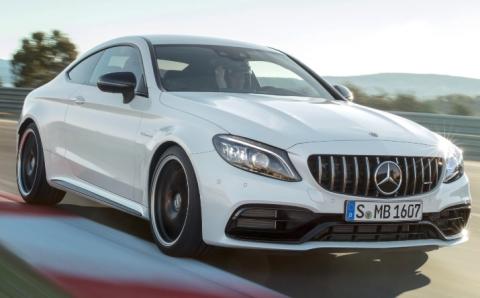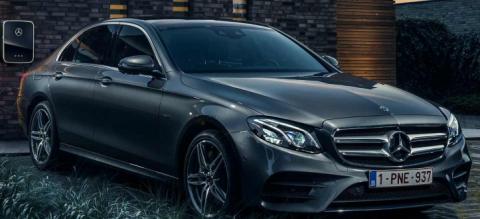New Mercedes E-Class Sedan AMG Line 2019 Review Interior Exterior.
Best Website for Auto Parts in All Europe AutoDoc Link :
https://interstitials.onelink.me/1036709825?pid=YouTube&c=SDADanCars
https://www.autodoc.co.uk?utm_source=youtube&utm_medium=referral&utm_campaign=SDADanCars
Also Check out Their Youtube Channel :
https://www.youtube.com/channel/UCKt9AEjnQYwR0vTvLJTAvgg
Outstanding fuel consumption figures require great aerodynamic properties. The new E-Class has the lowest drag coefficient in its segment. At the same time, the aerodynamics engineers have minimised the wind noise, thereby making the E-Class the quietest saloon in the executive class.
From a speed of about 70 km/h, the aerodynamic drag exceeds the sum total of all other driving resistance factors. Therefore, reducing the drag also helps to lower the fuel consumption and CO2 emissions. The metric for aerodynamics is the Cd value. Lowering it by 0.01 means one gram of CO2 per km less in the driving cycle (NEDC), while, in terms of average real consumption, it means two grams. Progress on the aerodynamic front has an even more significant effect at higher speeds – especially when driving on motorways. A Cd jump from 0.25 to 0.23 produces a fuel saving of around 0.3 litres per 100 kilometres at a constant 130 km/h.
Mercedes-Benz is setting the pace in the field of aerodynamics and delivers cars with the best drag coefficients (Cd values) in almost all vehicle classes. The new E‑C lass also follows this tradition: the saloon achieves a drag coefficient of from Cd = 0.23, which makes it the benchmark in the executive class.
Although the frontal area (A) of relevance for drag has risen in the new E-Class from the 2.31 square metres of the previous model series to around 2.33 square metres on account of the increased exterior dimensions, this is more than made up for by the reduced drag coefficient. The drag area (Cd x A) is 0.54 m2, which means that it has been reduced by almost seven percent in comparison with the previous model.
The design of the new E-Class impresses with its hallmark Mercedes saloon proportions. The elongated bonnet coupled with a coupé-esque roof flowing into a sensual, broad-shouldered tail end creates an exciting silhouette. Short overhangs, long wheelbase and large wheels emphasise the athletic character of the vehicle. The distance from the front wheel arch to the door opening, which is a measure of comfort, is exceptionally large in the case of the new E-Class, thus confirming its unique position.
The taut well-defined flanks display a fresh, stylish and dynamic interpretation of the feature line, which develops from the headlamps and extends over the whole vehicle length. A sculptural reverse curve in the lower region of the doors and in the bumper visually resumes the feature line while ensuring a stylistic tension. Low, stretched-looking side windows, surrounded by high-grade discontinuous aluminium trim around the window outline also contribute to the muscularly stretched vehicle body, which appears to be visually more compact than it actually is. The E-Class thus systematically embodies the Mercedes-Benz design philosophy of "sensual purity".
The new E-Class clearly shows a muscular front end that boasts a different look for each design and equipment line. The base version features the classic Mercedes radiator grille with the star on the bonnet, as does the EXCLUSIVE line – albeit in a different fashion. The AVANTGARDE and AMG Line models are identifiable by the sports radiator grille with a large Mercedes star as its centrepiece. Each of the radiator grille variants lends the E-Class a distinct character.
The intelligence of the new E-Class is reflected also in the headlamps. A characteristic element is the double eyebrow of the reinterpreted daytime running lamps. The face of the vehicle is shaped by distinctive headlamps with a clear-lens design.
The basic version of the E-Class comes with H7 headlamps. Static High Performance headlamps and MULTIBEAM LED headlamps are optionally available. They give the saloon a majestically focused look while featuring an unmistakable design, also by day, with double torch and high-quality modelled details.
A striking feature is the integration of the brand-typical daytime running lamp design in the High Performance and MULTIBEAM LED headlamps. Following the inner contour, it gives a distinctive note to the direction indicators, Coming Home lights, side lights and daytime running lamps. The result is that, in both their night and day design, the Mercedes-Benz E-Class models are uniquely identifiable, standing apart from other vehicles at the visual level.
All the headlamp functions are grouped under a lens of clear polycarbonate with scratch-resistant coating. Like various other design elements, the housing is in black, giving an impression of both quality and depth.
#SDADan
Best Website for Auto Parts in All Europe AutoDoc Link :
https://interstitials.onelink.me/1036709825?pid=YouTube&c=SDADanCars
https://www.autodoc.co.uk?utm_source=youtube&utm_medium=referral&utm_campaign=SDADanCars
Also Check out Their Youtube Channel :
https://www.youtube.com/channel/UCKt9AEjnQYwR0vTvLJTAvgg
Outstanding fuel consumption figures require great aerodynamic properties. The new E-Class has the lowest drag coefficient in its segment. At the same time, the aerodynamics engineers have minimised the wind noise, thereby making the E-Class the quietest saloon in the executive class.
From a speed of about 70 km/h, the aerodynamic drag exceeds the sum total of all other driving resistance factors. Therefore, reducing the drag also helps to lower the fuel consumption and CO2 emissions. The metric for aerodynamics is the Cd value. Lowering it by 0.01 means one gram of CO2 per km less in the driving cycle (NEDC), while, in terms of average real consumption, it means two grams. Progress on the aerodynamic front has an even more significant effect at higher speeds – especially when driving on motorways. A Cd jump from 0.25 to 0.23 produces a fuel saving of around 0.3 litres per 100 kilometres at a constant 130 km/h.
Mercedes-Benz is setting the pace in the field of aerodynamics and delivers cars with the best drag coefficients (Cd values) in almost all vehicle classes. The new E‑C lass also follows this tradition: the saloon achieves a drag coefficient of from Cd = 0.23, which makes it the benchmark in the executive class.
Although the frontal area (A) of relevance for drag has risen in the new E-Class from the 2.31 square metres of the previous model series to around 2.33 square metres on account of the increased exterior dimensions, this is more than made up for by the reduced drag coefficient. The drag area (Cd x A) is 0.54 m2, which means that it has been reduced by almost seven percent in comparison with the previous model.
The design of the new E-Class impresses with its hallmark Mercedes saloon proportions. The elongated bonnet coupled with a coupé-esque roof flowing into a sensual, broad-shouldered tail end creates an exciting silhouette. Short overhangs, long wheelbase and large wheels emphasise the athletic character of the vehicle. The distance from the front wheel arch to the door opening, which is a measure of comfort, is exceptionally large in the case of the new E-Class, thus confirming its unique position.
The taut well-defined flanks display a fresh, stylish and dynamic interpretation of the feature line, which develops from the headlamps and extends over the whole vehicle length. A sculptural reverse curve in the lower region of the doors and in the bumper visually resumes the feature line while ensuring a stylistic tension. Low, stretched-looking side windows, surrounded by high-grade discontinuous aluminium trim around the window outline also contribute to the muscularly stretched vehicle body, which appears to be visually more compact than it actually is. The E-Class thus systematically embodies the Mercedes-Benz design philosophy of "sensual purity".
The new E-Class clearly shows a muscular front end that boasts a different look for each design and equipment line. The base version features the classic Mercedes radiator grille with the star on the bonnet, as does the EXCLUSIVE line – albeit in a different fashion. The AVANTGARDE and AMG Line models are identifiable by the sports radiator grille with a large Mercedes star as its centrepiece. Each of the radiator grille variants lends the E-Class a distinct character.
The intelligence of the new E-Class is reflected also in the headlamps. A characteristic element is the double eyebrow of the reinterpreted daytime running lamps. The face of the vehicle is shaped by distinctive headlamps with a clear-lens design.
The basic version of the E-Class comes with H7 headlamps. Static High Performance headlamps and MULTIBEAM LED headlamps are optionally available. They give the saloon a majestically focused look while featuring an unmistakable design, also by day, with double torch and high-quality modelled details.
A striking feature is the integration of the brand-typical daytime running lamp design in the High Performance and MULTIBEAM LED headlamps. Following the inner contour, it gives a distinctive note to the direction indicators, Coming Home lights, side lights and daytime running lamps. The result is that, in both their night and day design, the Mercedes-Benz E-Class models are uniquely identifiable, standing apart from other vehicles at the visual level.
All the headlamp functions are grouped under a lens of clear polycarbonate with scratch-resistant coating. Like various other design elements, the housing is in black, giving an impression of both quality and depth.
#SDADan
- Category
- AMG








Comments